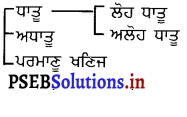This PSEB 8th Class Social Science Notes Chapter 3 Minerals and Energy Resources will help you in revision during exams.
Minerals and Energy Resources PSEB 8th Class SST Notes
→ Rock is a natural substance made up of one a more minerals.
→ Minerals: An inorganic substance which is found in the earth’s crust and it has a definite chemical composition.
→ Metallic minerals: Those minerals contain metals.
→ Minerals may be metallic or non-metallic.
![]()
→ Minerals can be ferrous and non-ferrous.
→ Mining: It is an economic activity of extracting valuable minerals from the earth.
→ Mine: It is an excavation in the ground for digging out minerals.
→ Recycling: It means using discarded materials once again.
→ Fossil fuels: They are fuels formed due to the decay of plants and animals millions of years ago.
→ Petroleum: It is derived from Latin words Petra meaning rock and oleum meaning oil. So, petroleum means rock oil.
→ Fossils: The decomposed creatures, minute plants, and animals buried and sedimented for millions of years.
→ Ore: Metals in their raw state as they are extracted from the earth.
→ Grid: Electricity from large power plants is transmitted through a network of power lines.
→ Minerals are extracted by mining, drilling, or quarrying.
![]()
→ Minerals can be conserved by recycling.
→ Mining is of four types:
- Opencast
- Shaft
- Quarrying
- Drilling
→ All rocks are composed of one or more minerals.
→ Copper was probably the first metal to be discovered and mined by man.
→ Mining is the extraction of minerals from the earth.
→ The distribution of mineral resources is uneven in India.
→ The main sources of power are coal, petroleum, and natural gas.
→ The non-conventional sources of power are sun, wind, tide, falling water, and geothermal sources.
→ Coal is the basis for all industrial development in the world.
→ About 65 percent of the mineral oil resources are found around the Persian Gulf.
→ Metallic minerals contain metal in raw form.
![]()
→ The Non-Metallic minerals do not contain metals.
→ Switzerland has no known mineral deposits in it.
→ A green diamond is the rarest diamond.
→ The oldest rocks in the world are in Western Australia.
→ Norway was the first country in the world to develop hydroelectricity.
खनिज एवं ऊर्जा संसाधन PSEB 8th Class SST Notes
→ धातु – लौह धातु, अलौह धातु
→ अधातु – परमाणु खनिज पदार्थ
→ धातु खनिज पदार्थ – कच्चा लोहा, मैंगनीज़, करोमाइट, निक्कल, कोबाल्ट, सोना, तांबा, चांदी, बॉक्साइट आदि खनिज धातु खनिज कहलाते हैं।
→ अधातु खनिज पदार्थ – इनमें अभ्रक, चूना पत्थर, हीरा, जिप्सम आदि खनिज शामिल हैं।
→ परमाणु खनिज पदार्थ – यूरेनियम, थोरियम तथा बेरिलियम परमाणु खनिज कहलाते हैं। इनसे हमें परमाणु ऊर्जा प्राप्त होती है।
→ शक्ति संसाधन-
- प्राचीन-कोयला, पेट्रोलियम, प्राकृतिक गैस, विद्युत् आदि।
- नवीन-सौर ऊर्जा, पवन शक्ति, ज्वारभाटा, भू-तापी ऊर्जा आदि।
ਖਣਿਜ ਅਤੇ ਸ਼ਕਤੀ ਸਾਧਨ PSEB 8th Class SST Notes
→ ਖਣਿਜ ਪਦਾਰਥ

→ ਧਾਤੂ ਖਣਿਜ ਪਦਾਰਥ-ਕੱਚਾ ਲੋਹਾ, ਮੈਂਗਨੀਜ਼, ਕਰੋਮਾਈਟ, ਨਿਕਲ, ਕੋਬਾਲਟ, ਸੋਨਾ, ਤਾਂਬਾ, ਚਾਂਦੀ, ਬਾਕਸਾਈਟ ਆਦਿ ਖਣਿਜ ਧਾਤੂ ਖਣਿਜ ਕਹਿਲਾਉਂਦੇ ਹਨ।
→ ਅਧਾਤੂ ਖਣਿਜ ਪਦਾਰਥ-ਇਸ ਵਿਚ ਅਬਰਕ, ਚੂਨਾ ਪੱਥਰ, ਹੀਰਾ, ਜਿਪਸਮ ਆਦਿ ਖਣਿਜ ਸ਼ਾਮਿਲ ਹਨ।
→ ਪਰਮਾਣੂ ਖਣਿਜ ਪਦਾਰਥ-ਯੂਰੇਨੀਅਮ, ਥੋਰੀਅਮ ਅਤੇ ਬੇਰੀਲੀਅਮ ਪਰਮਾਣੁ ਖਣਿਜ ਕਹਿਲਾਉਂਦੇ ਹਨ। ਇਨ੍ਹਾਂ ਤੋਂ ਸਾਨੂੰ ਪਰਮਾਣੂ ਊਰਜਾ ਪ੍ਰਾਪਤ ਹੁੰਦੀ ਹੈ।
→ ਸ਼ਕਤੀ ਸਾਧਨ-
- ਪ੍ਰਾਚੀਨ-ਕੋਲਾ, ਪੈਟਰੋਲੀਅਮ, ਕੁਦਰਤੀ ਗੈਸ, ਬਿਜਲੀ ਆਦਿ।
- ਨਵੀਨ-ਸੂਰਜੀ ਊਰਜਾ, ਪੌਣ ਸ਼ਕਤੀ, ਜਵਾਰਭਾਟਾ, ਭੂ-ਤਾਪੀ ਊਰਜਾ ਆਦਿ।
